A temple is a special place where people connect with their religious beliefs, and India is home to the most beautiful temples in the world. Additionally, India, being a secular country, has many temples of various religions. Each holds unique importance in the field of religion, culture, and history as well. Some of those are renowned for their architecture and mysterious history, while some gain popularity for their spiritual and interesting religious practices. From the infinite list of the best temples in India, we choose a few for this post.
Lotus Temple:
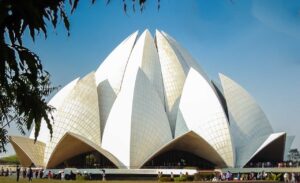
The Lotus Temple, a monument with European architectural touches, is located in the village of Bahapur in New Delhi, India. Besides, situated in the capital of India, it also takes after India’s national flower Lotus. This temple is a place of worship for the Bahai faith that emphasizes the unity of mankind and religions. The Lotus Temple was built by an Iranian-American architect Fariborz Sahba in 1986. This stunning shape of a half-bloomed lotus with surrounding nine pools attracts millions of visitors every year from across the world. Moreover, uniqueness of such Bahai houses of worship is that they neither follow any fixed pattern of worship nor allow any ritualistic ceremonies.
People also read :Taj Mahal : The Structure of Love
Golden Temple:
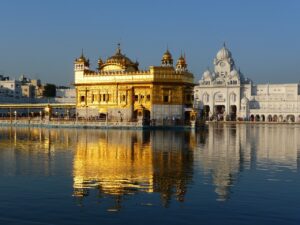
The Golden Temple, also known as Sri Harmandir Sahib, is a living symbol of the historical and spiritual traditions of Sikhism. It is located in the city of Amritsar in Punjab, a state in North India. The temple’s dome, glinting with pure gold, is one of the reasons that make it famous across the globe. Guru Arjan Dev Ji, the fifth Sikh Guru, started the construction of the Golden Temple in 1581 and it was completed in 1589. After that, he placed a copy of the Adi Granth, the holy scriptures of the Sikhs, in the temple in 1604. The subsequent Sikh Gurus and Sikh communities expanded and renovated this temple many times to further enhance its architectural beauty.
Kamakhya Temple:
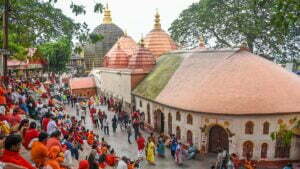
The Kamakhya Temple is one of the oldest temples in India and the most mysterious one. The temple is dedicated to mother Goddess Kamakhya, an incarnation of Goddess Durga (or goddes Sati). While most of the temples restrict the entry of female devotees during their menstruation, the temple celebrates this biological process. Also, this temple is a famous spot for Tantric practices.
The Kamakhya temple is one of the 51 Shakti Pithas of Goddess Sati and is considered the most vital one. Maa Kamakhya is the goddess of creative power, desire, and fertility. Here, Goddess Kamakhya is worshiped in the form of a Yoni(womb)- like stone, fed by a perennial stream, instead of any idol. Ambubachi Mela, one of the major attractions of this temple, is a celebration of the yearly menstruation course of Goddess Kamakhya. It celebrates every year during the monsoon season(mid-June) when the nearby Brahmaputra river turns red for three days. This Kamakhya Temple is certainly one of the best temples in India.
Kamakhya temple is situated at Nilachal Hills in Guwahati, the capital city of Assam, India. According to the records, the temple was initially built during the Mlechchha dynasty. Further, it was rebuilt and renovated several times between the period of 8th and 17th centuries. The current style of architecture is sometimes called the Nilachal type.
Konark Sun Temple:

Dedicating to Hindu God Surya (Sun), King Narasimhadeva I built the Konark Sun Temple in the 13th century CE. The temple is situated at Konark city, about 35 km northeast of Puri city on the coastline, in Odisha.
Konark Sun Temple is a great example of the Kalinga style of temple architecture. The floating idol is one of the most interesting features of the temple. This happens due to the use of magnets in their construction. The temple is designed in the form of the God Surya’s chariot with 24 wheels and 7 horses. The entire architecture of Konark Sun Temple collectively represents various passages of time. For its rich architecture and outstanding creativity of ideas, it was declared a UNESCO World Heritage Site in 1984.
The European sailors named the temple ‘Black Pagoda’ as its dark facade helped them to navigate. Though many portions of this temple are now ruined, what remains is enough to attract pilgrims as well as tourists across the globe.
People also read :Rath Yatra : A Festival Of Faith, Fervour And Festivity
Dilwara Temples:
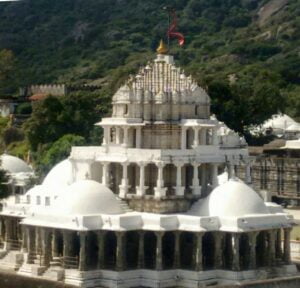
Dilwara Temples, a sacred pilgrimage of the Jains, is one of the best temples in India. It is situated about 2.5 km from Mount Abu, a hill station in the Sirohi district of Rajasthan, India. The Dilwara Temples are a group of five Jain temples, each dedicated to an individual Jain Tirthankaras( the spiritual teachers). It is said that the temples were built between the 11th and 13th centuries.
Among the five temples, Vimal Vashi Temple is the oldest one and it was built by Vimal Shah, a minister of Bhima I. These temples are a unique blend of architectural styles, including Maru Gurjara and Solanki. Its ornate design, intricate carvings, and impressive white marble construction have touched the hearts of millions of visitors across the world.
Mahabodhi Temple:

The list of the best temples in India is incomplete without a mention of the Mahabodhi Temple. It is located in the village of Bodh Gaya in Bihar, India. In around 260 BCE, Mauryan emperor Ashoka built this temple, dedicated to Lord Buddha, to commemorate the Buddha’s enlightenment. While the current temple was constructed between the 5th and 6th century AD.
Mahabodhi Temple was built in the Gupta architectural style and is one of the oldest brick structures that still stand today in eastern India. One of the most sacred places within the temple’s enclosed area is the Bodhi Tree. It is a fig tree, under which Siddhartha Gautama attained enlightenment or omniscient wisdom, and became the Buddha. The Bodh Gaya Act gave control of this ancient temple to the government of Bihar in 1949. After that Mahabodhi Temple was declared as a UNESCO World Heritage Site in 2002.
You can read the full article here: Mahabodhi Temple: The Enlightenment of Buddha
Sabarimala Temple:

The Sabarimala temple is one of the most famous temples in South India, dedicated to a Hindu deity named Ayyappan. Lord Ayyappan is considered a ‘God of righteousness and celibacy’ and is also known as Dharma Shasta. It is believed that Lord Ayyappan is the son of Lord Shiva and Mohini, a feminine avatar of Lord Vishnu.
This ancient temple is located within the 18 hills of the Western Ghat ranges of the Pathanamthitta district of Kerala. It is situated 1,260 m above sea level and is surrounded by mountains and dense forests. It is said that the Sabarimala temple was founded by Lord Parasuram but access to the temple was very difficult. So, around the 12th century, Rajasekhara Pandian, a Tamil king, discovered the original path that led to the temple.
Sabarimala has a unique set of customs and restrictions that govern the pilgrimage. Among those the restriction on entry for women of menstruation age (between 10 and 50 age group) is the most discussed one. It has been a subject of intense debate and legal battles. Despite various debates and controversies, it attracts thousands of pilgrims every day and is considered to be the biggest religious site in the world.
Trimbakeshwar Temple:

Trimbakeshwar temple of Maharashtra is one of the 12 jyotirlingas and is the most special one. The unique feature of this jyotirlinga temple is the presence of 3 lingas. They individually represent the three Lords- Brahma, Vishnu, and Shiva whereas all other jyotirlinga temples worship Lord Shiva only.
The Trimbakeshwar temple is situated in the town named Trimbak, about 28 km from the city of Nashik, in Maharashtra. The current temple was built by the third Peshwa Balaji Baji Rao in 1755-1786 AD and took almost 36 years to complete. This ancient temple was built in the Nagara style of architecture with black stone. And famous for its appealing architecture, sculpture, and some rituals like Narayan Nagbali puja, Kumbha Vivah, Rudra Abhishek, etc.
Thillai Nataraja Temple:
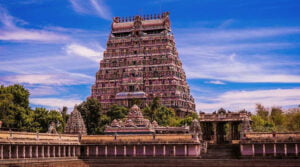
Undoubtedly, the Thillai Nataraja Temple, also known as Chidambaram Nataraja Temple, is one of the best temples in India. This South Indian temple is dedicated to Lord Nataraja, a dancing form of Lord Shiva. It is located in Chidambaram, a town in the Cuddalore district of Tamil Nadu, India. This temple has ancient roots and a shrine of Lord Shiva used to be there when the town was known as Thillai.
In the 10th century, the temple was constructed by Cholas, who considered Nataraja as their family deity. But most of the architecture and structure of the temple are from the late 12th and early 13th centuries. The Thillai Nataraja Temple represents India’s culture through its architecture. The postures of Bharatanatyam and the 108 karanas from Barata Muni’s Natya Shastra are visible in the temple’s wall carvings.
People also read : Bharatanatyam Dance – A Mesmerizing Journey of Classical Dance
‘Natyanjali’, a famous dance festival of the temple, is a tribute to Lord Shiva and is celebrated once a year. Other festivals like Nataraja Abhishekam, Arudra Darshan, and Shiva Ratri are also celebrated in this temple.
Chaturbhuj Temple, Orchha:
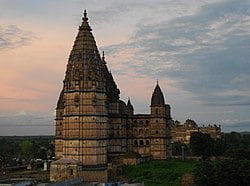
The Chaturbhuj Temple, dedicated to Lord Vishnu, was built in the 16th century by Bundela rulers of Orchha state. The word ‘Chaturbhuj’, means ‘One who has four arms’ and refers to Lord Rama, an incarnation of Lord Vishnu. This temple was initially constructed to deify an image of Lord Rama. But at present Lord Vishnu, Radha Krishna, and Devi Laxmi are worshiped here.
Most probably, Orchha king Madhukar Shah built this temple for his wife queen Ganeshkuwari. She was an ardent devotee of Lord Rama. She went to Ayodhya to obtain an image of Lord Rama that was intended to be enshrined in the newly built temple. But, when she returned, the construction of the temple was not completed. So initially she housed the idol in her palace, called Rani Mahal. Upon completion of the temple, several attempts were made to relocate the idol to the new temple. But it refused to be shifted from the Rani Mahal. From then Rani Mahal concerted into the Ram Raja Temple.
The Chaturbhuj Temple situated at Orchha town in Madhya Pradesh, India. King Madhukar Shah started the construction between 1558 and 1573 and his son, Vir Singh Deo completed it in the 16th century. This site is a blend of temple, fort, and palace architectural features. The temple’s exterior is richly ornamented with lotus symbols. A lot of people come here to witness the marvelous architecture of this temple.
In conclusion, Indian temples are not just places of worship but also a reflection of India’s rich cultural heritage, architectural brilliance, and spiritual significance. They are truly unique and a must-visit for anyone interested in exploring India’s rich history and culture.


Pingback: 5 Famous Mythological Shiva Temples in North India
Pingback: Mahabodhi Temple: The Enlightenment of Buddha - India Insights